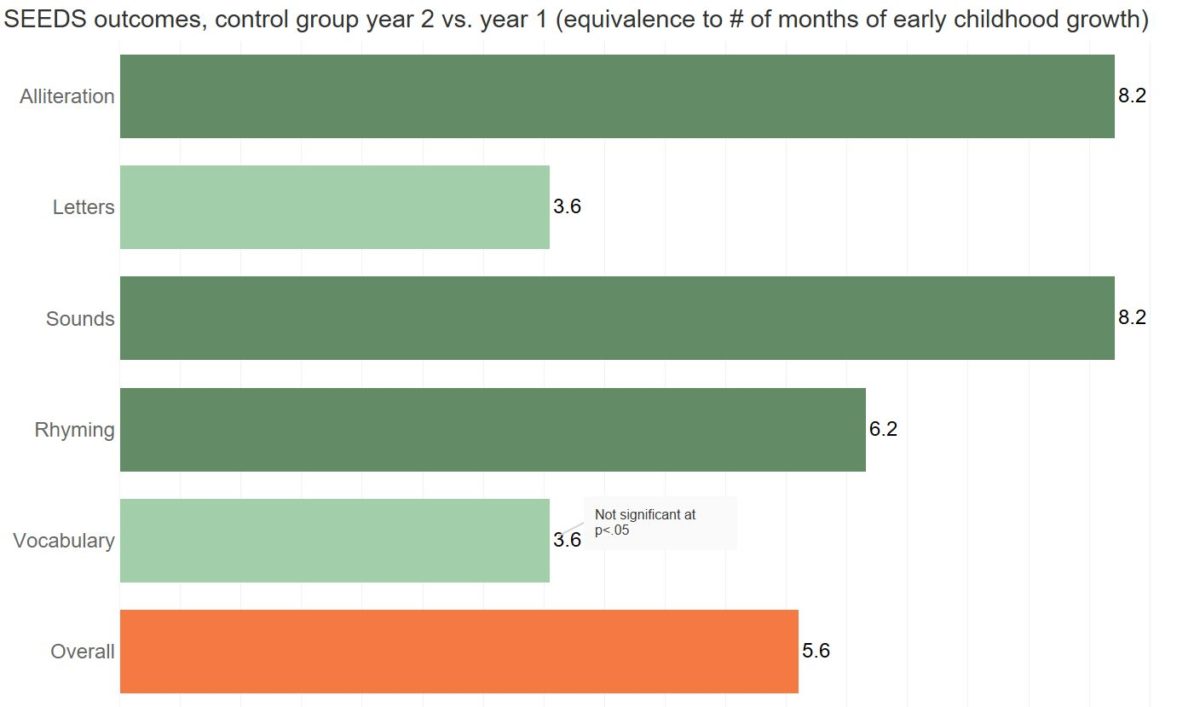Kidango is committed to evaluating the impacts of our programs to ensure a high-quality service that fully prepares children for Kindergarten. We work internally as well as with external partners to analyze the effects of our programs, enabling a process of continuous quality improvement.
NORC Results
NORC at the University of Chicago
In 2020, due to the pandemic, NORC decided to release the study’s Year 2 results because Year 3 was disrupted. Usually it takes time for a program like SEEDS to work, which is why the study was for three years. But Year 2 results were so strong, releasing them early was an easy decision.
The report from NORC can be found HERE.
The researchers from NORC found that “teachers with one year of SEEDS training helped their students achieve significantly higher end-of-year student emergent literacy outcomes than they did before SEEDS training the year prior. In study year 2 (2018-2019), students scored significantly higher in alliteration, rhyming, letter names, and letter sounds than the original 2017-2018 comparison group students (effect size range = .24 to 1.04 standard deviations). Given that typical early childhood students learn about 1.5 standard deviations a year in reading (Hill et al., 2008), these effect sizes represent impacts of a magnitude similar to between 2 and 8 months of learning.

As the figure shows, the overall impact of the SEEDs program is equivalent to almost 6 months of additional learning.
We can use the effects of those programs, as calculated by scientific studies, to compare the learning benefits for children across similar skills:

Sources:
| Boston: Weiland, Christina, and Hirokazu Yoshikawa. 2013. “Impacts of a Prekindergarten Program on Children’s Mathematics, Language, Literacy, Executive Function, and Emotional Skills.” Child Development 84 (6): 2112–30. |
| Georgia: Peisner-Feinberg, Ellen S., Jennifer M. Schaaf, Doré R. LaForett, Lisa M. Hildebrandt, and John Sideris. 2014. “Effects of Georgia’s Pre‐K Program on Children’s School Readiness Skills: Findings from the 2012–2013 Evaluation Study.” Chapel Hill: University of North Carolina, Frank North Carolina: Porter Graham Child Development Institute. http://fpg.unc.edu/sites/fpg.unc.edu/files/resources/reports-and-policy-briefs/GAPreKEval_RDDReport%203-4-2014.pdf. |
| Head Start: Puma, M., Bell, S., Cook, R., Heid, C., & Lopez, M. (2005). Head Start impact study: First year findings. Administration for Children & Families. |
| North Carolina: Peisner-Feinberg, Ellen S., and Jennifer M. Schaaf. 2011. “Summary of Key Findings Effects of the North Carolina More at Four Pre-Kindergarten Program on Children’s School Readiness Skills.” Chapel Hill: University of North Carolina, Frank Porter Graham Child Development Institute. http://fpg.unc.edu/sites/fpg.unc.edu/files/resources/reports-and-policy-briefs/MAF_Yr9_key_findings.pdf. |
| Tennessee: Lipsey, M. W., Farran, D. C., Bilbrey, C., Hofer, K. G., & Dong, N. (2011). Initial results of the evaluation of the Tennessee Voluntary Pre-K Program. Nashville, TN: Peabody Research Institute, Vanderbilt University. |
| Tulsa: Gormley, William T., Deborah Phillips, and Ted Gayer. 2008. “Preschool Programs Can Boost School Readiness.” CROCUS Working Paper No. 12. Washington, DC: Georgetown University. https://georgetown.app.box.com/s/fpq610v9n7iaqifvmquf. |





